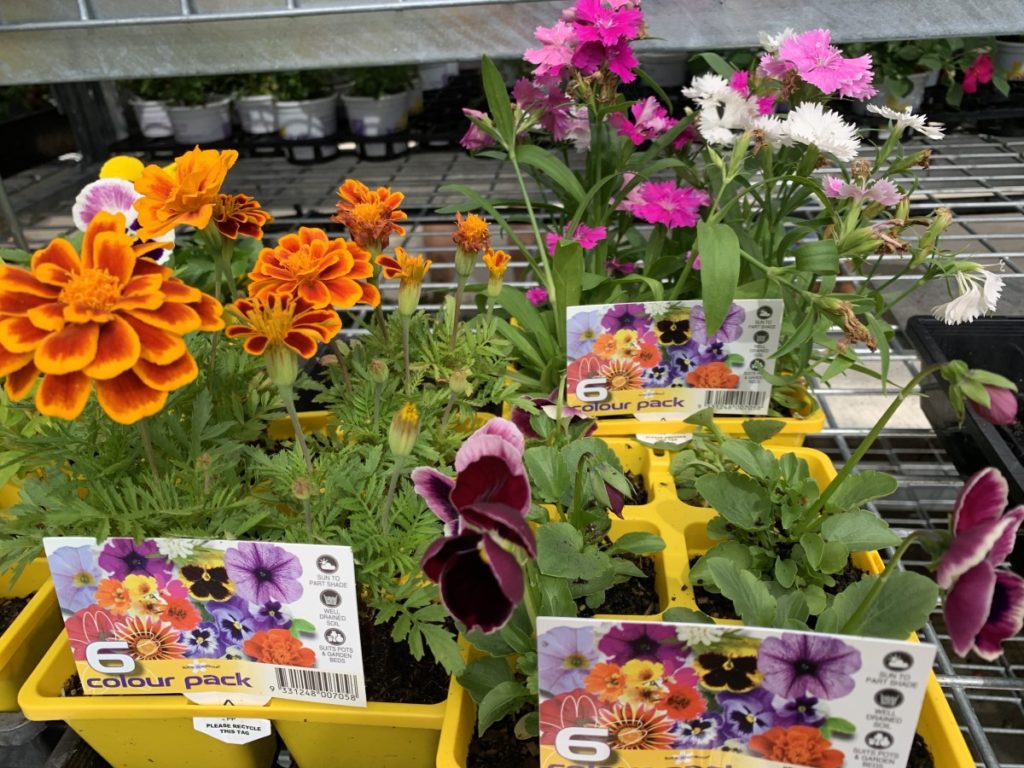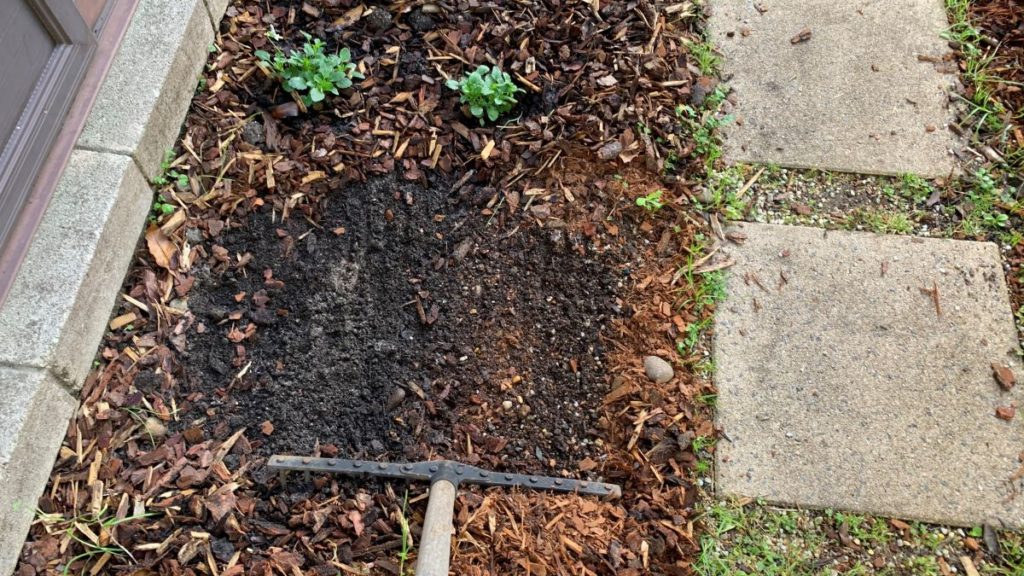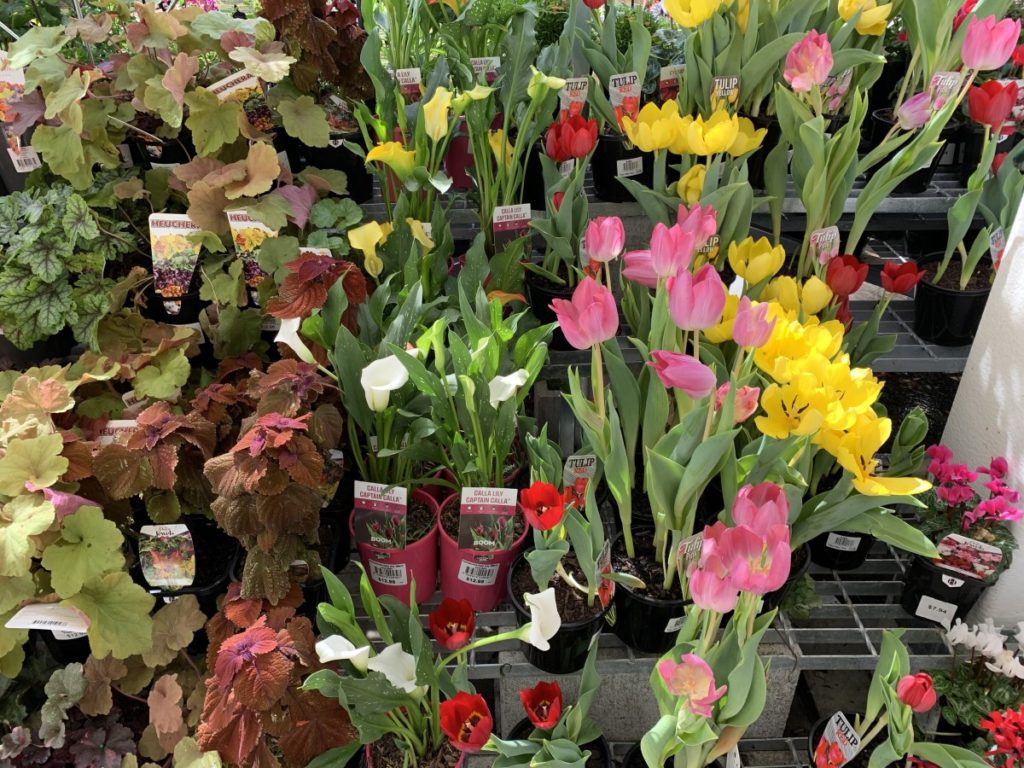Mulch after planting annuals to prevent mulch from being dug into the soil. Mulch will take nitrogen away from the plant if it is buried so apply mulch after you have dug the hole and planted. Add mulch around your annual flowers or vegetables after planting to keep moisture in and prevent weeds.
Why you should mulch after planting annuals
- Avoid mulch from falling in the hole as you dig
- Make it easier to dig compost or fertilizer into the soil
- Keep the mulch away from plant stems easily
- Keep soil moisture in by adding mulch after
- Keep mulch in place by watering it in after you plant

Mulching after planting annual flowers
Annual flowers are quick and easy to grow and will grow best you add mulch after you plant. If the area you are planting into already has mulch, use a rake to move it back and plant in the bare soil. This will make it easier to keep mulch out of the hole.
After you have planted your annual flowers like viola, pansies, alyssum or dianthus, you can move the mulch back around the plant. If you are adding new mulch sprinkle a layer around the plant root zone, covering the soil but leaving a 1-2 inch gap between the plant stem and the mulch.

Leaving a gap between the plant and the mulch will keep water away from the stem and help to prevent rot.
Mulching after planting annual vegetables
When you are replanting your vegetable garden with new annual vegetables clear the soil of mulch first before you plant. You can dig the mulch from last season into the soil if it is well broken down. Straw, hay or sugar cane mulch will break down over a few months so will be ready to dig into the soil when your plant has finished growing.
If you are planting vegetable seedlings like broccoli, cabbage or spinach add organic compost or aged cow manure to the soil first. Then plant your seedlings and surround them with straw or sugar cane mulch. This will help to keep moisture in the soil.

Water the plants after applying the mulch as the water will help to keep the mulch in place and stop it from blowing away. Make sure you add enough water to soak the plant roots to move the soil into place and fill any air gaps.
How to plant annuals after mulching
If you already have an established garden bed with mulch you can still plant annual flowers easily. Move the mulch back from the soil first. You can also dig a small amount of compost into the area at the same time.

Remove soil from the hole and place it into a small bucket or pot. This will stop it from mixing with the mulch when you go to backfill the plant. Place the plant in the hole and backfill with the soil. You can also add a handful of pelleted chicken manure to give your annuals and extra nutrient boost.
Annuals that like mulch
There are two main categories of annuals that prefer different types of mulch. Annual flowers will thrive when surrounded by a bark mulch. This looks great, lasts for around 6 months and will keep the moisture in the soil. It will also help to stop weeds from growing and taking nutrients and water from your flowers.
Annual vegetables prefer a lighter mulch like hay, straw or sugar cane. These mulches will break down quickly and add nutrients to the soil. Annual herbs like basil, parsley and coriander also like a light mulch
Mulching annuals with compost
Apply compost as a mulch when you plant annual flowers to give them long lasting nutrients. As you water the flowers, nutrients will be washed down into the plant root zone. You can also add a layer of bark mulch to the top of the compost to hold in extra water.

Compost is a fantastic mulch as it is light, low cost and can be completely organic. If you make compost at home you can simply layer it on top of the soil for free.
Mulching annuals with worm castings
Worm castings from your worm farm or bought online can be used as a mulch after planting annual flowers. Worm castings will help to keep moisture in and stop weeds from growing. Use worm castings to add extra nutrients to your vegetables and herbs.
When to mulching annual seeds
If you are planting annual flower seeds make sure you let the seedling grow to around 3-4 inches before adding mulch. If seeds are covered with mulch they will not get enough light and will struggle to grow through. Keep the soil uncovered until they grow.
If you are planting annual vegetable seeds like snow peas wait until the shoots have sprouted before mulching. When planting annual lettuce or pak choy, you can scatter sow the seeds over bare soil. Cover the seeds with a light layer of seed raising mix. You may not need to add mulch at all if you have sown them close together.

Guide to mulching annuals at home
It is important to keep all bare soil in your garden covered with mulch. This will keep the soil healthy and help to improve the structure, its ability to hold water and nutrient level for planting. When you are planting new annuals, simply remove any mulch first. Replace the mulch with the same mulch you removed or top it up with new mulch.
If you are planting wildflower seeds, do not mulch over the top of them. This will stop the light and prevent them from growing. If you are planting annual wildflowers, sowing them close together will create a tight mat of plants to choke out weeds.
I prefer to grow my wildflowers in pots first and plant them out when they are a few inches high. I will then surround the wildflowers with mulch to keep them growing well.
Mulch is an essential ingredient in any organic garden and can easily replace in-organic fertilizers over the long term. Over months and years of mulching it will be gradually mixed into the soil to build it up over time.
I am an accredited practicing dietitian, experienced gardener and a dedicated cook. I love writing and sharing my experience so you can learn from my successes and mistakes.

Comments are closed.